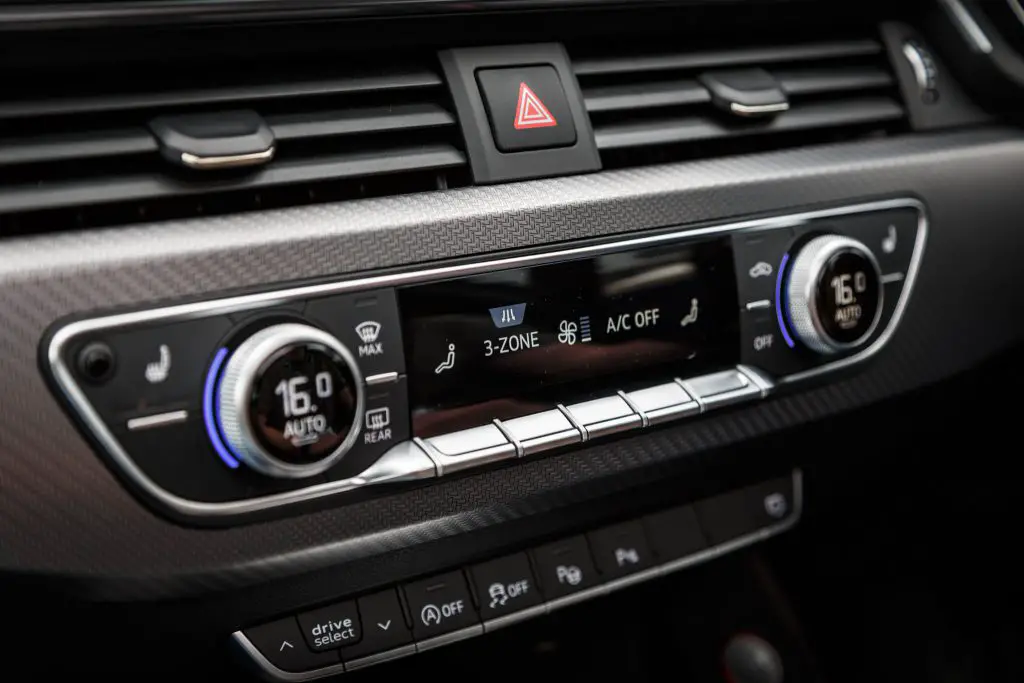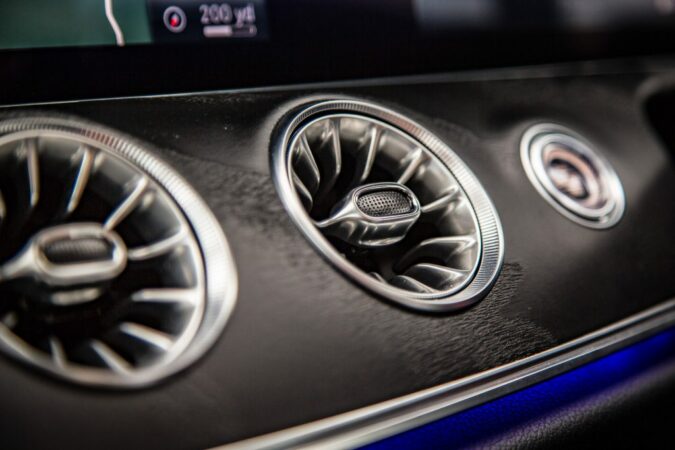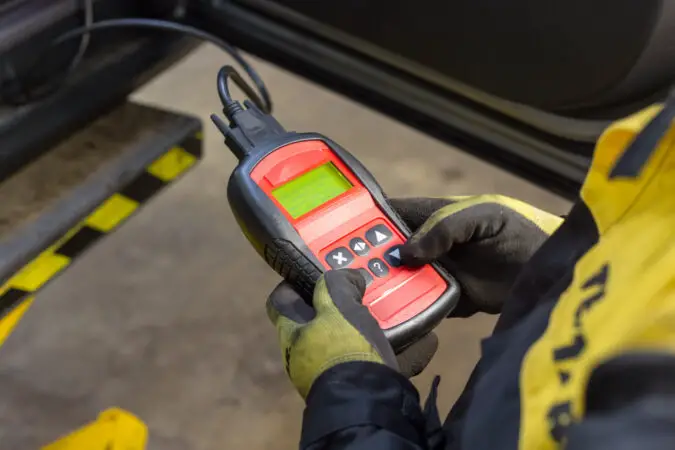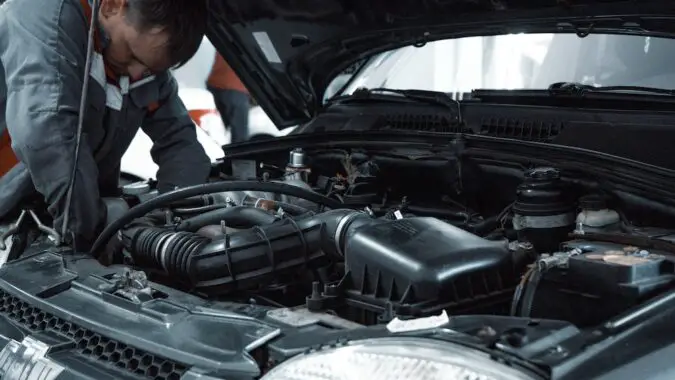There is no car feature more important than the air-conditioning system. Especially if you live somewhere where the summers get really hot. The heart of the system is the AC condenser in your car. And if it goes bad, you’re going to have trouble staying cool in the summer.
If your air-conditioning system isn’t quite as cool as it usually is, or you suspect you have problems with it, you have good reason to suspect it’s the condenser. This post will discuss everything you need to know, and here’s our table of contents to help you find the relevant topics for you:
What’s An AC Condenser In Car?
The AC condenser is a device that looks like your car engine’s radiator. It works in a similar way too. The condenser cools down the system’s refrigerant, and it usually has a fan to help cool it down.
It’s located at the front of the car, just behind the car’s grille. As you drive along, outside air will flow through the grille and through the condenser which helps to cool down the refrigerant. Here’s a more in-depth explanation of how the system works:
How The Air Conditioning System Works
The air-conditioning system in your car works the same way as your home’s air-conditioning system, just at a much smaller scale. Also, power comes from the engine, rather than an electrical outlet. Here are the components and the process:
- When you turn on the air-conditioning system, the engine’s drive belt runs the AC compressor in your car.
- The compressor, as the name suggests, compresses the refrigerant which is still in a gaseous state at this stage. It becomes high-temperature and high-pressure gas.
- Afterward, the gas travels into the condenser, which is a heat-removing device that looks like your car’s radiator. The condenser removes the heat, and the gas loses pressure and temperature and transforms into a liquid.
- The condenser also has a dryer, which removes any remaining gas and only allows liquid to flow through the system afterward.
- The liquid then travels into an expansion valve, which is another high-pressure system that transforms the liquid back into a gas and drops further down in temperature. At this point, the gas will reach around 32 degrees Fahrenheit.
- Then the refrigerant gets into the evaporator. Then a blower motor will blow air from the outside through the evaporator. Since the gas in the evaporator is cold, the air passing through it becomes cold. This results in cold air being blown through the vents, cooling the cabin of the car.
- The refrigerant travels back into the compressor and repeats the process.
We recommend watching the video above to understand the inner workings of each component. The system works the same way in every car, including EVs. However, the system is powered by the battery in EVs, since there’s no engine and drive belt.
Symptoms Of A Bad AC Condenser In Car
Like any other car part, the AC condenser can go bad after a while. Here are the symptoms you might experience:
1. Hot Air From The A/C Vents
The most obvious and likely sign would be hot air blowing through the vents. It may not be instant though. Instead, the air may become increasingly warm over time. And this can happen over the course of a day or even a month.
Point is, if your A/C is not quite as cold as it usually is, it’s possible that you have condenser issues. There are three possible causes: the condenser is dirty, it’s leaking out the refrigerant, and/or the condenser fan is faulty.
If it’s dirty, then the refrigerant’s flow can become interrupted. This disrupts the entire process, resulting in a less-cool refrigerant flowing into the evaporator. If the condenser is leaking out refrigerant, then the system becomes less effective as well.
Finally, the condenser’s fan also plays a crucial role in cooling down the refrigerant as it flows through the condenser. When the fan stops working or isn’t blowing as fast, the refrigerant temperature won’t drop as much as it should. As a result, the refrigerant is warmer than usual as it passes through the evaporator and the air isn’t as cold.
The most common sign of a faulty condenser fan is if the AC is only cold when driving, and then gets hot when you’re stationary or idling. This is because the condenser gets cold air passing through it when you’re driving, but since the fan isn’t working and there’s no cold air when you’re idling, the condenser gets warmer.
2. Refrigerant Leaks
Unlike a coolant, oil, or other leaks in your car, a refrigerant leak from the condenser is unlikely to result in a puddle underneath the car. Instead, the more likely scenario is that you’ll notice the condenser unit is covered in oil or grease-like liquid.
Oil travels with the refrigerant in the system to lubricate it, although refrigerant still makes the majority of it. Anyway, if there’s a leak in the condenser, the oil will leak out as well and leave traces behind. Resulting in oil residue on the condenser.
So, if you suspect you have a leaking condenser, inspect it and see if it’s dry. As mentioned, the condenser is usually at the front just behind the grille. It looks like your car’s radiator but smaller. After using the car’s A/C system, it should be completely dry. But if it’s covered in a grease-like liquid, then you have a condenser leak.
Note that severe leaks—especially if it happens at the bottom of the condenser—can result in a puddle of refrigerant underneath the car. This is because the refrigerant only transforms to liquid when it reaches the bottom.
Most refrigerants are colorless and odorless, so you may mistake them for water from the A/C system’s condensation which is perfectly normal. However, a refrigerant has a higher density than water, so it feels thicker to the touch. Additionally, some refrigerants have a gray-greenish color, but your car may or may not use this.
3. Burning Smell From The A/C
The condenser’s main purpose is to release heat from the refrigerant and transforms it back into a liquid state. If you have a faulty condenser, then it can’t release this heat properly, resulting in overheating of the air-conditioning system and a burnt smell through the vents.
A burning smell is alarming, but if you only smell it while the air-conditioning system is on, then it’s likely the A/C system and not a fire starting in your engine bay. In any case, it’s good to have a fire extinguisher in your car in case of emergencies. Better be safe than sorry.
4. Overheating While Idling
Since a faulty condenser can’t disperse heat from the refrigerant and causes the air-conditioning system to overheat, this can also affect engine temperature. The heat from the air-conditioning system can raise the engine and coolant temperature as well, especially when the car is idling since no cool air is blowing through it.
This is unlikely to happen, as modern car cooling systems are very good at dealing with extreme heat. But some people have reported it. So, if the engine is overheating while using the A/C system at idle, there’s good reason to suspect you have a bad condenser.
Keep in mind that there are myriad possible causes for overheating at idle. Read our guide on how to troubleshoot an overheating car to learn more.
5. Dashboard Warning Light
Your car’s instrument cluster is full of warning lights that can light up when the car’s computer detects an issue. When there’s an issue the car can’t fix on its own, your car will register a Diagnostic Trouble Code (DTC) in the On-Board Diagnostic (OBD) system. This will turn on the warning light on your dashboard depending on what the issue is.
You can then scan the OBD system with an OBD scan tool to find the trouble codes. They won’t tell you what’s causing the problem, as it’s not smart enough to do that. But they will tell you what’s wrong with the car and helps with the diagnostic process.
However, as far as we can tell, there are no trouble codes that specifically signal an issue with the condenser. At least, not the generic ones. Instead, common A/C-related trouble codes such as the P0534 code signal a compressor issue usually caused by low refrigerant.
Since A/C systems don’t lose refrigerants cause it’s a closed-loop system, this means you have a leak, and the condenser might be the source. Again, there are no generic condenser trouble codes. However, it’s possible your specific car make has a manufacturer-specific code for this.
How To Check The AC Condenser In Your Car
Checking the condenser is pretty straightforward in most cars. However, some cars may require you to remove the front bumper just to be able to visually inspect it. In any case, you’ll want to look out for these things:
- Corrosion or excess dirt and debris on the condenser. In the case of dirt, you may be able to fix the issue by cleaning the condenser.
- Missing or bent fins. The condenser looks just like a radiator with fins on the outside. Missing or bent fins will reduce the condenser’s ability to disperse heat, causing A/C system issues and overheating.
- Structural damage to the frames and other parts of the condenser.
- Turn on the car’s air-conditioning, and inspect the fan behind the condenser. If the fan isn’t running, you have a faulty fan. Note some cars don’t have a fan for the condenser.
The video above will show you what a bad condenser looks like. If your condenser looks anything like in the video above, you’re going to have to replace it. But if it seems fine, then you either have a leak or a different component in the system that’s faulty.
The most common part to go bad is the compressor, and the most common sign is usually strange noises when you turn on the air-conditioning system. Read our article about bad AC compressors to learn more (as well as how to tell if AC compressor is bad).
As for leaks, we mentioned that condenser leaks will leave traces of oil behind. And you can also use a UV light if the refrigerant in your has UV dye mixed into it. But if it doesn’t, and you want to verify whether or not you have a leak, then here’s what you can do:
How To Find AC Leaks
First, get hold of a refrigerant kit. Such as the Arctic Freeze Ultra Synthetic Refrigerant. However, make sure you get the correct type (check the service manual), and make sure you get the one with a UV dye. Also, wear safety goggles and gloves while you do this. Afterward, here’s what you need to do:
- Start the engine, and turn on the A/C system to full.
- Locate the A/C system’s low-pressure valve. The valve is on the A/C lines, usually running into the compressor. The valve cover usually says ‘L’ or ‘Low’.
- Connect the kit to the valve and pull the trigger. If the pressure gauge is low then that’s confirmation you have low refrigerant. If the gauge is in the green, this means you have enough refrigerant and you have an issue somewhere else.
- Keep pulling the trigger. Turn the bottle from the 6 o’clock position to the 9 o’clock position repeatedly to make sure the UV dye and oil mix in. You’ll need to do this until the gauge is in the green, usually about 10 minutes.
- Depending on the severity, you may need to drive a car for up to a couple of days before the UV dye will show up. Severe leaks will show up immediately.
- Get the car into a dark space, then shine a UV light on all of the components to find the leak. You’ll see green spots under UV light if there’s a leak.
The video above from ChrisFix is a complete guide on how to find AC leaks in your car. Note that after you find the leak and repair it, you should not use a refrigerant kit to refill the system. Refilling the refrigerant needs to be precise, and overfilling or underfilling it can cause premature damage.
Car AC Condenser Replacement Cost
Once you verify that the AC condenser is bad or leaking, you’re going to have to replace it. The cost ranges from $580 to $780 on average including labor. Parts are usually around $250, while labor is around another $300. Note that this usually doesn’t include the cost to top up the refrigerant, which is usually another $150 on average.
Other repairs relating to the condenser include replacing the fan and wiring repairs if there’s damage to the condenser fan’s wires. Replacing the fan is usually between $300 and $425 on average. Meanwhile, most wiring repairs are between $200 and $300 depending on the extent of the damage.
Since the cost is quite high, you might be tempted to do the job yourself and save money and labor cost. However, we don’t recommend this as it’s quite difficult to do unless you’re a trained mechanic.
The process entails draining the refrigerant, removing the old condenser, and then installing the new one and connecting all the A/C lines and pipes back to it. Afterward, you’ll need to refill the refrigerant which you’ll have to do at a shop anyway since refilling the system with a refrigerant kit is not recommended.
So, unless you know what you’re doing—in which case you don’t need our help anyway—you shouldn’t attempt this replacement job yourself. You can easily mess things up and make it worse, best to leave it the pros. However, if your condenser is simply dirty, then you can clean it by yourself:
Car AC Condenser Cleaner
Note that in most cars this process still requires you to remove your front bumpers to gain access to the condenser. If you’re not comfortable with dismantling the front bumper, then you should skip this and let a professional do it for you. Otherwise, you need a coil cleaner, and the rest of the process is pretty easy:
- Use a vacuum cleaner to get rid of some of the larger dirt and debris. You may also use a soft brush for stubborn debris, but be very gentle as you may damage the fins.
- Prepare the coil cleaner, some of them need to be mixed with water. Read the instructions, but otherwise, shake the can and then spray the cleaner onto the condenser.
- Wait for a few minutes until the foam is no longer visible. Then rinse the condenser with clean water. Don’t use a pressure washer as it can damage the fins.
- Use a blow gun or a can of compressed air duster to blow the remaining water out of the condenser.
- Reinstall the bumper.
Pretty easy, no? Aside from taking off and reinstalling the bumper, cleaning the condenser is easy and takes no time at all. Afterward, your air-conditioning system is likely to have cooler air blowing. However, if it’s still not quite as cold, then you might need to do some repairs. Our guide to A/C system repairs should be of help to you.
Car AC Condenser Cleaning Facts:
- A dirty car AC condenser can lead to poor AC performance and decreased efficiency.
- Cleaning the car AC condenser can promote its optimum performance and increase AC efficiency.
- Cleaning the car AC condenser requires caution and the right products and tools to protect the engine, brush, apply the solution, and rinse.
- The necessary products and tools for cleaning car AC condenser include a screwdriver, wrench, garbage bags, shop-vac with soft-bristled brush attachment, coil cleaner, garden hose, air compressor with a blow gun, and protective gear.
- To clean the car AC condenser, the front bumper of the car needs to be removed, which varies depending on the car’s make and model.
- Before cleaning the AC condenser, necessary precautions should be taken to protect the engine from damage.
- Dirt and debris on the AC condenser can be removed using a shop-vac with a soft-bristled brush attachment or a soft-bristled brush.
- A coil cleaner specifically designed for cleaning an AC condenser should be applied to the AC condenser and left to sit for at least five minutes.
- After the coil cleaner has worked on the grime and grease, the AC condenser should be rinsed with a garden hose, avoiding the engine’s wires.
- After cleaning, the AC condenser should be dried using an air compressor with a blow gun and the front bumper should be reinstalled.
AC Condenser Car FAQ
Here are the answers to common questions about A/C condensers in a car:
What Is An AC Condenser In A Car
The AC condenser in a car is part of the AC system that removes heat from the high-pressure refrigerant and turns it back into a liquid. The liquid will then travel through the AC lines into the evaporator to create cool air for the car’s AC. The condenser looks similar to a car radiator, albeit smaller.
How To Check Car AC Condenser
You can visually inspect it and look for these: corrosion, oil residue (a sign of a leak), and damage to the fins or the condenser’s structure. Any of those issues will require you to replace the condenser. Meanwhile, if there’s dirt or mold on the condenser, cleaning it by using a coil cleaner may suffice. You should also turn on the car’s AC and see if the fan is working. Note that some cars will require you to remove the front bumper to be able to visually inspect the condenser.
How To Flush Car AC Condenser
Flushing the AC condenser requires you to drain the system of refrigerant, and then use a cleaning solution to run through the system and forces it out of an outlet hole of the condenser. There’s a debate on whether or not flushing the A/C is necessary. But in any case, we don’t recommend doing this yourself as you may damage the system in the process. Best have a professional mechanic do it for you.
How To Recharge Car AC After Condenser Replacement
Recharging it properly will require a vacuum pump, a set of manifold gauges, and refrigerant. You can also use a refrigerant kit that delivers the refrigerant in a can equipped with a gauge and a nozzle. However, this isn’t recommended as you can’t accurately refill the system. Overfilling or underfilling can cause damage. It’s really a lot easier to just have a professional do it for you rather than going through the trouble yourself.
How Long Does It Take To Replace A Car AC Condenser
Professional mechanics will need around 3 to 5 hours to replace the AC condenser in your car, depending on the complexity of your car’s A/C system.
How To Test Car AC Condenser Fan Motor
Disconnect the fan’s electrical connector, then clip a couple of alligator clips onto it. Then take the other end of the clip, and connect it to the car’s battery. Turn the car’s key to the ‘ACC’ position, and the fan should spin. If it spins, then you have wiring damage between the fuse box and the wiring connector. If it doesn’t spin, you have a bad fan motor which you will need to replace.
AC Condenser Car: Wrap Up
To summarize, the AC condenser is a device that releases heat from the refrigerant which transforms it into a liquid. The liquid then flows out of the condenser, where it will ultimately flow into the evaporator and a blower motor blows air through it. The resulting air becomes warm, and you have a nice cool breeze in the car.
While the condenser is not a moving component, it can go bad after a while. They usually go bad due to corrosion and damage from rocks and other road debris, which can cause a leak or the condenser to lose its efficiency. The condenser fan may also stop working which can affect the system’s efficiency.
The condenser itself is usually rated to last for about 15 years. But it’s not uncommon for them to fail earlier than that. Damages to the fan will require you to replace it since repairs are not possible. But if it’s just dirty, a good cleaning with a coil cleaner may suffice.
Cleaning your condenser every two years or so may help to prevent corrosion and prolong its lifespan. Hopefully, this has been helpful for you and can help you to maintain your car’s air-conditioning system and stay cool throughout the year.





